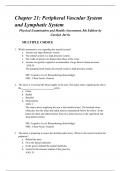Exam (elaborations)
Chapter 21: Peripheral Vascular System and Lymphatic System Physical Examination and Health Assessment, 8th Edition by Carolyn Jarvis
- Course
- Institution
Physical Examination and Health Assessment, 8th Edition by Carolyn Jarvis MULTIPLE CHOICE 1. Which statement is true regarding the arterial system? a. Arteries are large-diameter vessels. b. The arterial system is a high-pressure system. c. The walls of arteries are thinner than those...
[Show more]



